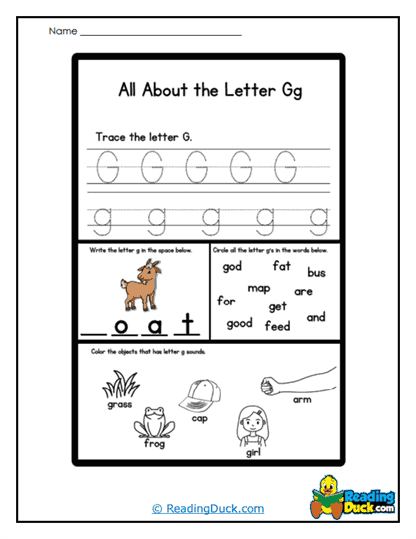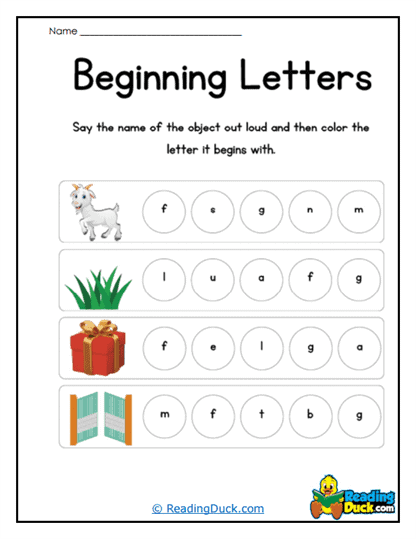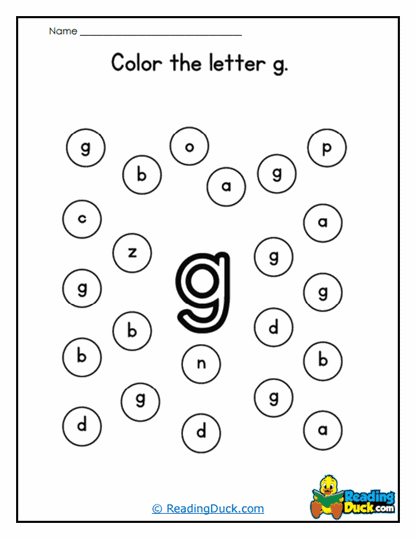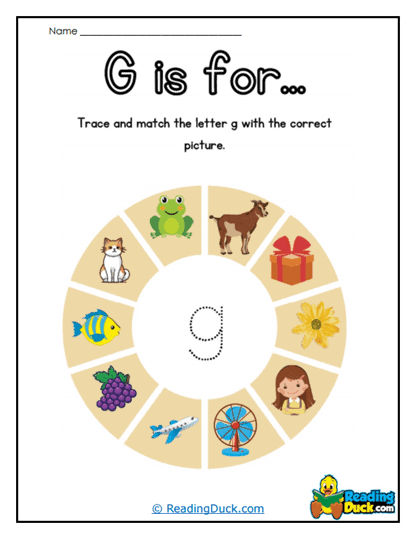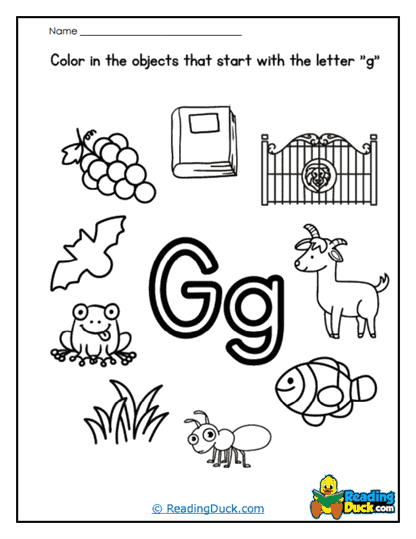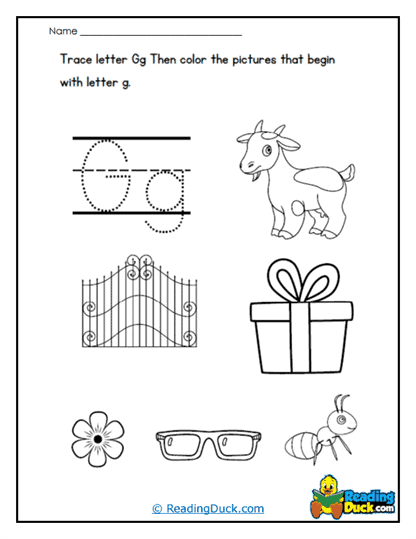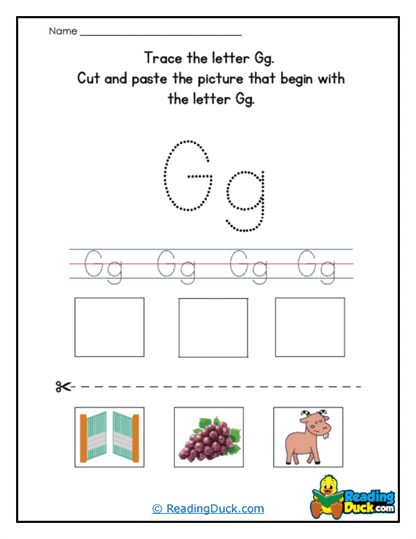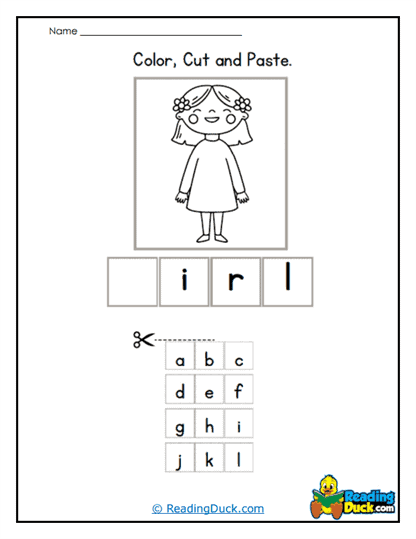Letter G Worksheets
About Our Letter G Worksheets
All worksheets in this collection contain Letter G worksheets that are visually engaging to young students. This collection includes various activities designed to improve young learners’ familiarity with the letter G, focusing on reading, recognizing, and writing it. These worksheets are readily available in PDF format, making them easy to view electronically, download, and print for use. An answer key is provided for each worksheet to assist both teachers and parents in guiding students.
The Significance of Learning the Letter G
The letter G is an essential component of the alphabet and plays a crucial role in early literacy development. When introducing the letter G to students, it’s important to explore its various aspects, ensuring that students fully grasp its significance and how it fits into the broader context of language learning.
Key Aspects of the Letter G:
- Alphabetical Position and Usage: The letter G is the seventh letter in the alphabet. Understanding its place within the sequence helps students develop a strong foundation in alphabetical order, which is a fundamental skill in reading and writing. G appears in many common words, making it a letter that students will encounter frequently as they progress in their literacy journey.
- Phonetic Sound: The letter G can produce two primary sounds: the hard /g/ sound, as in "goat" or "gum," and the soft /j/ sound, as in "giraffe" or "gem." Introducing students to both sounds is vital for building phonemic awareness, a skill that allows them to decode and pronounce new words correctly.
- Visual Recognition: Recognizing the letter G in both its uppercase (G) and lowercase (g) forms is a key skill. Students should be able to identify the letter G in various fonts and contexts, which will help them become more flexible and confident readers. Exposure to the letter G in different styles aids in this recognition.
- Writing Practice: Writing the letter G involves mastering its distinct shape, which is different from many other letters in the alphabet. Practice tracing and writing both uppercase and lowercase G is important for developing fine motor skills and reinforcing letter recognition. Proper stroke order and formation should be emphasized to ensure that students develop good handwriting habits from the start.
- Vocabulary Development: Associating the letter G with words helps expand students' vocabulary. Words like "goat," "grass," and "gate" provide concrete examples that students can easily relate to. Using images and real-life objects to represent these words can enhance understanding and make the learning process more engaging.
- Incorporating the Letter G in Daily Life: Encouraging students to find the letter G in their environment—whether it’s on signs, in books, or in spoken language—helps them connect their learning to the real world. This practical application reinforces their understanding and makes learning more meaningful.
- Interactive and Multi-Sensory Learning: Incorporating multi-sensory activities, such as tracing the letter G in sand or using clay to mold the letter, engages students in a hands-on manner. These activities help solidify their understanding of the letter G while making the learning experience fun and memorable.
By focusing on these aspects, teachers can provide students with a well-rounded understanding of the letter G, setting them up for success in their reading and writing endeavors.
Integrating Letter G Worksheets into the Curriculum
Creative Strategies for Using Letter G Worksheets in the Classroom or Homeschooling Environment
The Letter G worksheets can be a valuable resource in helping young learners develop their literacy skills. Here are some practical and creative ways to incorporate these worksheets into a teaching curriculum:
- Morning Literacy Warm-Up: Begin each day with a quick exercise focusing on the letter G. Students can start with a worksheet that practices letter recognition and writing as part of their morning routine. This helps to set the tone for the day and reinforces the letter G in a structured yet engaging manner.
- Letter of the Week Program: Dedicate a week to the letter G, incorporating it into various subjects and activities. Each day could focus on different elements of the letter, such as identifying words that start with G, practicing writing the letter, and finding G in stories. The worksheets can provide structured practice to reinforce these lessons.
- Storytime Integration: Choose a story that features the letter G prominently, such as "Goldilocks and the Three Bears" or "Goodnight Moon." After reading the story, students can complete a worksheet related to the letter G, helping them connect the sound and shape of the letter to the words and themes in the story.
- Alphabet Hunts: Organize an alphabet hunt where students look for objects that begin with the letter G around the classroom or at home. After the hunt, students can use the worksheets to write down the words they found, reinforcing the connection between the letter and the objects.
- Interactive Games: Create games that involve the letter G, such as a matching game where students match uppercase and lowercase G, or a memory game using words that start with G. Incorporating these worksheets into the game adds an element of fun while providing valuable practice.
- Art and Craft Projects: Engage students in art projects where they create the letter G using various materials such as glitter, glue, or paint. These projects can be paired with worksheets that allow students to practice writing and identifying the letter G in a more structured way.
- Group Activities: Set up stations where students can rotate through different activities related to the letter G. One station might involve tracing the letter on a worksheet, while another could include a listening activity where students identify words that start with G from a recording.
- Homework Assignments: Use Letter G worksheets as homework to reinforce what has been taught in class. This allows parents to be involved in their child’s learning, providing support and additional practice at home.
- Cross-Curricular Connections: Link the study of the letter G to other subjects. For example, in science, students could learn about animals like goats or gorillas, and then complete a worksheet related to the letter G. In art, students could draw pictures of things that start with G and label them accordingly.
- Digital Learning Opportunities: If technology is available, consider using digital versions of the worksheets. Students can practice tracing and writing the letter G on a tablet, or use interactive apps that reinforce letter recognition and phonics. This modern approach can be especially engaging for tech-savvy learners.
Grade Levels That Benefit from Letter G Worksheets
These worksheets are particularly suited for Pre-Kindergarten, Kindergarten, and early First Grade students. They are designed to help early learners develop essential literacy skills by focusing on letter recognition, phonics, and handwriting. Additionally, English Language Learners (ELL) in the early grades may find these worksheets beneficial as they build foundational language skills in English.
Enhancing Skills Through Letter G Worksheets
The Importance of Learning the Letter G in Early Childhood Education
The activities in these Letter G worksheets go beyond simple letter recognition and writing practice. They support the development of a wide range of skills that are crucial for academic success and personal growth:
- Fine Motor Skills: Tracing and writing the letter G helps young learners develop fine motor skills, which are essential for writing and other tasks that require hand-eye coordination. The repeated practice on these worksheets strengthens the muscles in the hands and improves dexterity.
- Phonemic Awareness: Recognizing the sound that the letter G makes is a key component of phonemic awareness. This foundational skill enables students to decode new words and supports their overall reading development.
- Cognitive Development: Completing these worksheets requires students to focus, follow directions, and solve problems. These cognitive skills are important not just for literacy, but for all areas of learning.
- Language and Vocabulary Building: As students work with the letter G, they are exposed to new words and concepts, which helps expand their vocabulary. This is critical for developing strong communication skills.
- Confidence and Independence: Successfully completing tasks related to the letter G builds students’ confidence. As they master each new letter, they gain a sense of accomplishment, which encourages them to tackle more challenging tasks independently.
- Creativity and Expression: Engaging with the letter G through various activities, such as drawing or storytelling, allows students to express themselves creatively while reinforcing their literacy skills.
- Social and Collaborative Skills: Group activities centered around the letter G foster collaboration and communication among students. These social skills are important for working effectively in teams and developing positive relationships with peers.
By incorporating these worksheets into the learning environment, teachers and parents can help students build a strong foundation in literacy while also supporting their overall development. The skills learned through these activities will serve students well as they continue their educational journey.
The Value of Mastering the Letter G
Why Mastering the Letter G is Essential for Early Learners
Mastering the letter G is a critical step in a child’s early literacy development. The activities in these worksheets provide young learners with the tools they need to recognize, write, and understand the letter G, laying the groundwork for future reading and writing success. By engaging with the letter G through these worksheets, students not only develop their literacy skills but also enhance their cognitive, motor, and social abilities. This comprehensive approach ensures that students are well-prepared for the challenges of learning and growing in an academic environment.
